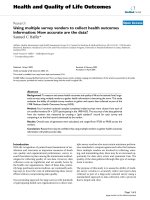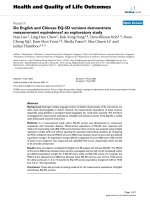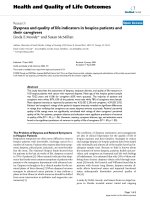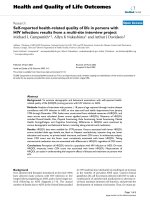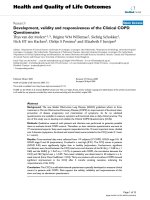Health and Quality of Life Outcomes BioMed Central Research Open Access Do English and Chinese doc
Bạn đang xem bản rút gọn của tài liệu. Xem và tải ngay bản đầy đủ của tài liệu tại đây (255.95 KB, 7 trang )
BioMed Central
Page 1 of 7
(page number not for citation purposes)
Health and Quality of Life Outcomes
Open Access
Research
Do English and Chinese EQ-5D versions demonstrate
measurement equivalence? an exploratory study
Nan Luo
1
, Ling-Huo Chew
2
, Kok-Yong Fong
3,4
, Dow-Rhoon Koh
3,4
, Swee-
Cheng Ng
4
, Kam-Hon Yoon
3,4
, Sheila Vasoo
4
, Shu-Chuen Li
1
and
Julian Thumboo*
3,4
Address:
1
Department of Pharmacy, National University of Singapore, Singapore,
2
School of Health Sciences, Nanyang Polytechnic, Singapore,
3
Department of Medicine, National University of Singapore, Singapore and
4
Department of Medicine, National University Hospital, Singapore
Email: Nan Luo - ; Ling-Huo Chew - ; Kok-Yong Fong - ; Dow-
Rhoon Koh - ; Swee-Cheng Ng - ; Kam-Hon Yoon - ;
Sheila Vasoo - ; Shu-Chuen Li - ; Julian Thumboo* -
* Corresponding author
Abstract
Background: Although multiple language versions of health-related quality of life instruments are
often used interchangeably in clinical research, the measurement equivalence of these versions
(especially using alphabet vs pictogram-based languages) has rarely been assessed. We therefore
investigated the measurement equivalence of English and Chinese versions of the EQ-5D, a widely
used utility-based outcome instrument.
Methods: In a cross-sectional study, either EQ-5D version was administered to consecutive
outpatients with rheumatic diseases. Measurement equivalence of EQ-5D item responses and
utility and visual analog scale (EQ-VAS) scores between these versions was assessed using multiple
regression models (with and without adjusting for potential confounding variables), by comparing
the 95% confidence interval (95%CI) of score differences between these versions with pre-defined
equivalence margins. An equivalence margin defined a magnitude of score differences (10% and 5%
of entire score ranges for item responses and utility/EQ-VAS scores, respectively) which was felt
to be clinically unimportant.
Results: Sixty-six subjects completed the English and 48 subjects the Chinese EQ-5D. The 95%CI
of the score differences between these versions overlapped with but did not fall completely within
pre-defined equivalence margins for 4 EQ-5D items, utility and EQ-VAS scores. For example, the
95%CI of the adjusted score difference between these EQ-5D versions was -0.14 to +0.03 points
for utility scores and -11.6 to +3.3 points for EQ-VAS scores (equivalence margins of -0.05 to +0.05
and -5.0 to +5.0 respectively).
Conclusion: These data provide promising evidence for the measurement equivalence of English
and Chinese EQ-5D versions.
Published: 17 April 2003
Health and Quality of Life Outcomes 2003, 1:7
Received: 11 March 2003
Accepted: 17 April 2003
This article is available from: />© 2003 Luo et al; licensee BioMed Central Ltd. This is an Open Access article: verbatim copying and redistribution of this article are permitted in all media
for any purpose, provided this notice is preserved along with the article's original URL.
Health and Quality of Life Outcomes 2003, 1 />Page 2 of 7
(page number not for citation purposes)
Background
With health-related quality of life (HRQoL) being increas-
ingly used as an endpoint in multi-national clinical trials,
it is often necessary to use two or more language versions
of a HRQoL instrument in any given study. In such stud-
ies, it would be ideal to pool data from each language ver-
sion of a HRQoL instrument for statistical analysis to
increase the statistical power and representativeness of
such research [1]. In order to do so, these different lan-
guage versions should measure the same construct (i.e. di-
mensions of HRQoL) with the same metric; in other
words, language versions of a HRQoL instrument should
demonstrate measurement equivalence. According to
Drasgow and Kanfer [2], different language versions of a
HRQoL instrument would demonstrate measurement
equivalence if they yielded similar scores at item and scale
levels for respondents with identical levels of HRQoL.
Measurement equivalence, also referred to metric equiva-
lence [3], differs from conceptual equivalence and psy-
chometric equivalence. Conceptual equivalence refers to
similarity in meaning of items across language versions of
an instrument [3], and aims to ensure that different lan-
guage versions measure the same construct. Psychometric
equivalence refers to similarity in psychometric properties
such as floor and ceiling effects, reliability and construct
validity [4]. Conceptual equivalence and psychometric
equivalence are prerequisites for measurement equiva-
lence but do not necessarily ensure measurement equiva-
lence. To date, few studies have investigated measurement
equivalence for different language versions of HRQoL in-
struments [5].
Measurement equivalence of language versions of an in-
strument is of particular concern in several situations,
which are addressed in this study. First, measurement im-
precision is more likely to arise in brief instruments. The
EQ-5D self-report questionnaire [6] exemplifies this, as
information for each of its 5 dimensions is derived from
only one item. Second, versions of an instrument in lan-
guages which differ in semantic structure may also be
more prone to imprecision. For example, score differences
are more likely to arise in comparing scores of English and
Chinese versions of an instrument (which are alphabet
and pictogram-based respectively) than in comparing
scores from 2 alphabet-based versions.
The purpose of this study was therefore to evaluate the
measurement equivalence of English and Chinese ver-
sions of the EQ-5D [6], a brief utility-based HRQoL in-
strument which is widely used in multi-national clinical
trials [7]. The English and Chinese EQ-5D versions used
in this study were adapted for use in Singapore using the
EuroQol Group's cultural adaptation guidelines [8], thus
facilitating conceptual equivalence, and (at the time this
manuscript was published) are regarded as 'best available'
language versions by the EuroQol Group's Translation
Committee [9]. These EQ-5D versions have demonstrated
similar psychometric properties [10,11], suggesting psy-
chometric equivalence. Thus, in the current study, we
aimed to evaluate the measurement equivalence of these
versions by studying if differences in item responses and
scale scores between these versions exceeded pre-defined
values (corresponding to the minimal clinically impor-
tant difference) in patients with rheumatic diseases.
Methods
Study design
A consecutive sample of outpatients with rheumatic dis-
eases seen at a tertiary referral hospital within a 2-week pe-
riod were interviewed by trained nurse interviewers using
an identical English or Chinese questionnaire containing
the Singaporean English or Chinese EQ-5D, a 10 cm pain
visual analog scale (VAS), and assessing psychosocial, so-
cio-demographic and other variables. Written consent was
obtained from each subject for this IRB-approved study.
Inclusion criteria were physician diagnosis of a rheumatic
disease and ability to cooperate with the interview. This
research was part of a larger study of English and Chinese
EQ-5D versions in subjects with rheumatic diseases
[10,11].
Instruments
The EQ-5D consists of a health descriptive system and a
visual analog scale (EQ-VAS) for respondents to self-clas-
sify and rate their health on the day of administration of
the instrument [6,7]. The descriptive system has 5 items/
dimensions (i.e., mobility, self-care, usual activities, pain/
discomfort and anxiety/depression), and for each item,
there are three response levels (i.e., no problems, moder-
ate problems and extreme problems). The items can be
used individually or in combination (as a health profile)
as descriptive measures in clinical studies. Theoretically,
the design of the descriptive system identifies as many as
243 unique health states, although a small number of
these health states are not plausible in reality [12]. Scoring
methods have been developed to assign each of these
health states a utility score in which 1 represents full
health (no problems with all 5 items) and 0 represents be-
ing dead [12,13]. EQ-5D utility scores can be used to cal-
culate quality-adjusted life-years (QALYs) for cost-utility
analysis of health interventions [14,15]. The EQ-VAS is a
vertical, graduated (0–100 points) 20 cm 'thermometer',
with 100 at the top representing 'best imaginable health
state' and 0 at the bottom representing 'worst imaginable
health state'. The EQ-VAS score can be used as a measure
of clinical outcome, using individual respondents' own
judgment [16].
Health and Quality of Life Outcomes 2003, 1 />Page 3 of 7
(page number not for citation purposes)
Singaporean English and Chinese EQ-5D versions were
derived by adapting the UK English [7] and the Taiwan
Chinese versions respectively, using the EuroQol Group's
guidelines for cultural adaptation of the EQ-5D [8]. The
resulting Singaporean English EQ-5D is identical to its
source UK English version except that the word 'box' in
the instructions for the EQ-VAS was replaced with 'BLACK
BOX' [10]. We found this amendment improved respond-
ents' compliance with EQ-VAS instructions to link the box
representing 'your own health state today' to the scale.
Changing the word 'box' to 'BLACK BOX
' was also adopt-
ed for the Singaporean Chinese EQ-5D [11].
Statistical analysis
We evaluated the equivalence of English and Chinese EQ-
5D versions by examining whether score differences be-
tween these versions were clinically important. Based on
the definition of Drasgow and Kanfer [2], if these differ-
ences were clinically unimportant, these versions would
demonstrate measurement equivalence. Using methodol-
ogy for assessing therapeutic equivalence in clinical trials
[17,18], we therefore compared the 95% confidence inter-
val (95%CI) of EQ-5D item, utility and VAS score differ-
ences with pre-defined equivalence margins to determine
if differences in scores were clinically important or unim-
portant. Each equivalence margin represented a range of
score differences which would be too small to be clinically
important. Comparing the 95% CI for a score difference
with its corresponding equivalence margin could lead to
1 of 3 possible results [17,18], illustrated graphically in
Figure 1. First, if the 95%CI fell completely within the
equivalence margin, the score difference would be clini-
cally unimportant, and measurement equivalence would
be demonstrated (Figure 1, option A). Second, if the
95%CI did not overlap with the equivalence margin at all,
the score difference would be clinically important, and
non-equivalence would be demonstrated (Figure 1, op-
tions E and F). Third, if the 95%CI partially overlapped
with the equivalence margin, the score difference might or
might not be clinically important, and either equivalence
or non-equivalence might be present (Figure 1, options B,
C and D).
We defined equivalence margins for responses to items,
utility and EQ-VAS scores after calculating utility scores
using the algorithm developed by Dolan [12]. Ideally,
each equivalence margin should be based on the minimal
clinically important difference (MCID) [19] for that score.
However, as these have not been specified in the EQ-5D
literature, we defined equivalence margins based on the
best available data (see below). Score differences were as-
sessed using logistic regression models for responses to
Figure 1
Possible relationships between equivalence margins and 95% confidence intervals (95%CI) of score difference
between English and Chinese EQ-5D versions Note: Horizontal lines represent the 95% confidence intervals of differ-
ence in EQ-5D scores between English and Chinese versions.
Health and Quality of Life Outcomes 2003, 1 />Page 4 of 7
(page number not for citation purposes)
EQ-5D items and linear regression models for EQ-5D util-
ity and EQ-VAS scores, with or without adjustment for
influence of other variables which might influence HR-
QoL (e.g. age, gender, socio-economic status). It was im-
portant to adjust for the influence of these variables when
assessing influence of language, as observed differences in
EQ-5D scores might be caused by these determinants rath-
er than by questionnaire language.
Score differences for each EQ-5D item were examined us-
ing logistic regression models (one model for each item).
Responses to each item were treated as a binary dependent
variable (no problems = 0/with problems = 1) by combin-
ing response levels 2 (moderate problems) and 3 (extreme
problems). Language version was coded into a dummy
variable (Chinese = 0/English = 1). Each model was con-
structed by first entering language version as the only in-
dependent variable; other selected independent variables
were entered subsequently. These variables were age,
gender, years of education, employment status and pain
VAS score, which were selected because they differed sub-
stantially between the two groups (Table 1) and have been
reported to correlate with responses to the EQ-5D [20–
26]. Age and pain VAS scores were treated as continuous
Table 1: Characteristics of subjects completing the English or Chinese EQ-5D
n (%) unless stated
English (n = 66) Chinese (n = 48) p-value*
Mean ± SD (median) age 44.3 ± 17.2 (43.0) 56.7 ± 12.4 (57.0) <0.001
Female gender 48 (72.7) 45 (93.8) 0.006
Chinese ethnicity 45 (68.2) 48 (100) -
Employed/full time student 38 (57.5) 13 (27.1) 0.010
Six or less years of education 8 (12.1) 31 (64.6) <0.001
Married 40 (60.6) 38 (79.2) 0.597
Acute medical condition present
†‡
50 (75.8) 36 (75.0) 0.926
Chronic medical condition present
§
27 (40.9) 28 (58.3) 0.066
Mean ± SD (median) 10 cm pain VAS score
‡
3.3 ± 2.7 (2.6) 4.7 ± 2.2 (4.6) 0.003
Tender points present 42 (63.6) 31 (64.6) 0.883
Rheumatic disease
Osteoarthritis 9 (13.6) 15 (31.3) 0.006
Rheumatoid Arthritis 26 (39.4) 23 (47.9)
Systemic Lupus Erythematosus 23 (34.8) 8 (16.7)
Spondyloarthropathy 8 (12.2) 2 (4.1)
Response to EQ-5D items
Mobility
No problems 50 (75.8) 40 (83.3) 0.327
Some problems 16 (24.2) 8 (16.7)
Extreme problems 0 (0) 0 (0)
Self-care
No problems 66 (100) 46 (95.8) 0.094
Some problems 0 (0) 2 (4.2)
Extreme problems 0 (0) 0 (0)
Usual activities
No problems 50 (75.8) 43 (89.6) 0.125
Some problems 15 (22.7) 4 (8.3)
Extreme problems 1 (1.5) 1 (2.1)
Pain/discomfort
No pain/discomfort 14 (21.2) 11 (22.9) 0.889
Moderate pain/discomfort 49 (74.2) 34 (70.8)
Extreme pain/discomfort 3 (4.5) 3 (6.3)
Anxiety/depression
No anxiety/depression 40 (60.6) 30 (62.5) 0.098
Moderate anxiety/depression 26 (39.4) 15 (31.2)
Extreme anxiety/depression 0 (0) 3 (6.3)
*Chi-square or t-test † Acute medical conditions included upper respiratory tract infections, vomiting or diarrhoea, headache lasting more than 1
day, insomnia and injuries. ‡ The recall period for the pain VAS and acute medical conditions was the preceding 4 weeks. §Chronic medical condi-
tions included hypertension, diabetes mellitus, stroke, cancer, joint replacement and limb fractures.
Health and Quality of Life Outcomes 2003, 1 />Page 5 of 7
(page number not for citation purposes)
variables while the remaining variables were coded into
dummy variables. In the model for pain/discomfort item,
pain VAS score was not included, as both variables meas-
ure pain and therefore did not represent an independent-
dependent relationship (a necessary assumption for re-
gression models [27]). Based on previous study designs
for detecting therapeutic equivalence [18,28], we pre-de-
fined an equivalence margin of (-10%, +10%) for each
EQ-5D item. Thus, if the difference in the proportion of
subjects reporting problems for an item was less than ±
10% between the 2 language groups, the item demonstrat-
ed measurement equivalence as defined for this study. The
95%CI of the regression coefficient (i.e. odds ratio) for
language version was converted into the 95% CI of the
proportion derived from this odds ratio to facilitate com-
parison with the equivalence margin of (-10%, +10%)
[29].
Score differences in EQ-5D utility and EQ-VAS scores were
examined using separate linear regression models, with
and without adjustment for variables potentially influenc-
ing HRQoL (listed above). The 95%CI of the regression
coefficient of language version was compared with pre-de-
fined equivalence margins to determine measurement
equivalence. We reviewed the literature but found no re-
ports regarding the MCID of EQ-5D utility or EQ-VAS
scores; however, we found that differences in mean EQ-
5D utility and EQ-VAS scores in individuals differing in
health status were seldom less than 5% of their entire
score ranges (i.e., 0.05 points for utility scores and 5.0
points for EQ-VAS scores) [23–25,30–33]. We therefore
defined equivalence as a difference of less than 5% of the
respective score ranges, that is, (-0.05, +0.05) for utility
and (-5.0, +5.0) for EQ-VAS scores.
Results
Subject characteristics
The mean (SD) age of the 114 interviewed subjects was
49.4 (16.5) years, with 81.6% (n = 93) being female and
57.9% (n = 66) completing the English EQ-5D. English
EQ-5D respondents were younger (44.3 vs. 56.7 years, p <
0.001) and more likely to be male (27.3% vs. 6.2%, p <
0.01), employed (57.5% vs. 27.1%, p = 0.01), better edu-
cated (6 or less years of education: 12.1% vs. 64.6%, p <
0.001) and reported less pain (mean pain VAS score: 3.3
vs. 4.7, p < 0.01) than Chinese-speaking respondents.
Other characteristics of the two groups of subjects are
summarized in Table 1.
Comparison of responses to EQ-5D items
Equivalence was assessed for mobility, usual activities,
pain/discomfort items and anxiety/depression items, but
not for the self-care item as subjects completing the Eng-
lish EQ-5D reported no problems with this item (Table
1), which did not allow a logistic regression model to be
created. The 95%CIs of odds ratios and corresponding
proportion intervals for language version are summarized
in Table 2. Before adjusting for other variables, the influ-
ence of language partially overlapped with the equiva-
lence margin of (-10%, +10%) for all items,
corresponding to options B or D in Figure 1. The lower
bound of the 95%CIs ranged from -20.9 to -17.0%. The
upper bound of the 95%CI for mobility, usual activities
and pain/discomfort items was less than or approximately
+10%; that for the anxiety/depression item was 17.1%. Af-
ter adjusting for the influence of other variables, the
95%CIs changed slightly but still overlapped partially
with the equivalence margin for all items. The lower
bound ranged from -29.9 to -20.0%; the upper bound was
less than or approximately +10% for 3 items and 26.3%
for the anxiety/depression item.
Comparison of EQ-5D utility and EQ-VAS scores
The 95%CIs of effect sizes for language version on EQ-5D
utility and VAS scores are summarized in Table 3. Before
adjusting for other variables, the influence of language
partially overlapped with the equivalence margin for both
utility and VAS scores, with the 95%CI of the effect of lan-
Table 2: Logistic regression: the influence of language version on EQ-5D item responses
Dependent variable Unadjusted influence of language version Adjusted influence of language version*
Odds ratio
(95%CI)
p-value Corresponding proportion
interval
Odds ratio
(95%CI)
p-value Corresponding proportion
interval
Mobility 1.60 (0.62, 4.12) 0.330 (-17.0% to +9.8%) 2.09 (0.60, 7.30) 0.249 (-20.0% to +10.5%)
Usual activities 2.75 (0.93, 8.13) 0.067 (-20.4% to +1.4%) 4.16 (1.01, 17.09) 0.048 (-22.4% to -0.2%)
Pain/discomfort 1.10 (0.45, 2.70) 0.828 (-20.9% to +10.4%) 1.21 (0.38, 3.87) 0.752 (-29.9% to +11.9%)
Anxiety/depression 1.08 (0.50, 2.33) 0.838 (-17.6% to +17.1%) 0.97 (0.34, 2.77) 0.956 (-20.4% to +26.3%)
95%CI = 95% confidence interval; Chinese language was the reference group; self-care was excluded because no problems were reported by sub-
jects completing the Singaporean English EQ-5D. *Adjusted for the influence of age, gender, years of education, employment status and pain VAS
score. Pain VAS score was not included in the model for the pain/discomfort item.
Health and Quality of Life Outcomes 2003, 1 />Page 6 of 7
(page number not for citation purposes)
guage version being (-0.07, +0.09) and (-3.5, +8.8), re-
spectively. This corresponded to options D and C
respectively in Figure 1. After adjusting for the influence of
other variables, the 95%CIs were (-0.14, +0.03) and (-
11.6, +3.3) respectively, which again partially overlapped
with the respective pre-defined equivalence margins of (-
0.05, +0.05) and (-5.0, +5.0).
Discussion
Many HRQoL instruments have been developed in one
language for use in one country, then translated and cul-
turally adapted for use in other countries. This approach
has been adopted by the International Quality of Life As-
sessment Project (IQOLA) [34] and the European Organ-
isation for Research and Treatment of Cancer (EORTC)
Quality of Life Study Group [35]. In addition to conceptu-
al and psychometric equivalence, measurement/metric
equivalence of different language versions of a HRQoL
instrument developed using this approach also needs to
be assessed as a necessary prelude to pooling data from
these versions into a single analytical framework in clini-
cal trials.
In this study, we investigated the measurement equiva-
lence of Singaporean English and Chinese versions of EQ-
5D by applying methodology used to assess therapeutic
equivalence of medical interventions in clinical trials. This
involved comparing the 95%CI of the score differences
between these language versions against a corresponding
pre-defined equivalence margin (which corresponded to a
magnitude of score differences which were felt to be clin-
ically unimportant). The 95%CI of differences in EQ-5D
item responses and utility and VAS scores between these
versions, with or without adjustment for confounding
variables, partially overlapped with their respective pre-
defined equivalence margins. Our data thus provide
promising evidence for the equivalence of Singaporean
English and Chinese EQ-5D versions, and justify a larger
study to conclusively address this issue, possibly matching
respondents by health status and socio-demographic
characteristics to reduce the potential confounding effects
of these factors. Our study is one of few investigations into
the measurement equivalence of different language ver-
sions of EQ-5D using outcome scores of the EQ-5D. Such
studies are meaningful and useful for the various language
versions of both the EQ-5D and other HRQoL scales. In a
previous study, using item-response theory (IRT) [36], in-
vestigators confirmed the cross-cultural comparability of
EQ-5D items across 10 different European language ver-
sions in outpatients with schizophrenia [37]. These re-
sults, though encouraging, cannot be generalized to other
language versions of EQ-5D or to subjects without
schizophrenia.
Defining an equivalence margin for different language
versions of a HRQoL instrument involves specifying the
magnitude of difference in scores between versions that is
clinically unimportant (i.e. that would not adversely in-
fluence the results of research which pooled data from
these versions [18]). Theoretically, the equivalence mar-
gin should be no larger than the minimal clinically impor-
tant difference (MCID) of the scales in that instrument.
However, to the best of our knowledge, the MCID for the
EQ-5D has not been established. The equivalence margins
used in this study were therefore estimated from the best
available literature, and need to be confirmed in studies
specifically assessing the MCID for EQ-5D item responses
and utility and EQ-VAS scores.
We recognize several limitations of this study. First, the
sample size was relatively small, because data from a vali-
dation study were used. In general, studies to assess
equivalence need larger sample size [17]. Second, study-
ing subjects attending a rheumatology clinic in a tertiary-
care hospital limited the generalizability of our results.
However, the results of this exploratory study are encour-
aging and do justify a larger study to further address the
important issue of measurement equivalence for this
widely used instrument.
Conclusion
In conclusion, the results of this exploratory study suggest
that Singaporean English and Chinese EQ-5D versions
may demonstrate measurement equivalence. This study
provides justification for further research to investigate
the measurement equivalence of these and other EQ-5D
language versions, so that results from these versions in
clinical trials may be pooled for analysis, thus increasing
the representativeness and power of such studies.
Table 3: Linear regression: the influence of language version on EQ-5D utility and visual analog scale scores
Dependent variable Unadjusted effect size (95%CI) p-value Adjusted effect size (95%CI)* p-value
EQ-5D utility score 0.01 (-0.07, 0.09) 0.851 -0.05 (-0.14, 0.03) 0.214
EQ-VAS score 2.7 (-3.5, 8.8) 0.396 -4.1 (-11.6, 3.3) 0.276
95%CI = 95% confidence interval; Chinese language was the reference group; EQ-VAS = EQ-5D Visual Analog Scale *Adjusted for the influence of
age, gender, years of education, employment status and pain VAS score.
Health and Quality of Life Outcomes 2003, 1 />Page 7 of 7
(page number not for citation purposes)
Authors' contributions
NL and JT designed and supervised the study, analyzed
and interpreted data, and drafted the manuscript. LHC
provided administrative and technical support and super-
vised the study. SCL provided administrative and techni-
cal support. All authors except SCL contributed to data
collection. All authors made critical revisions of the man-
uscript for important intellectual content and approved
the final manuscript.
Acknowledgements
We would like to thank staff nurses from the Nanyang Polytechnic Ad-
vanced Diploma in Nursing Course for their help in interviewing subjects.
References
1. Thumboo J, Fong KY, Chan SP, Machin D, Feng PH, Thio ST and Boey
ML The equivalence of English and Chinese SF-36 versions in
bilingual Singapore Chinese Qual Life Res 2002, 11:495-503
2. Drasgow F and Kanfer R Equivalence of psychological measure-
ment in heterogeneous populations J Appl Psychol 1985, 70:662-
680
3. Anderson RT, Aaronson NK, Leplege AP and Wilkin D Internation-
al use and application of generic health-related quality of life
instruments In: Quality of life and Pharmacoeconomics in Clinical Trials
(Edited by: Spilker B) Philadelphia, Lippincott-Raven 1996, 613-632
4. Lohr K, Skillman S and with 1999 Health Outcomes Methodology
Symposium Glossary for health outcomes methodology Med
Care 2000, 38(suppl):II7-13
5. Anderson RT, Aaronson NK, Bullinger M and McBee WL A review
of the progress towards developing health-related quality-of-
life instruments for international clinical studies and out-
comes research Pharmacoeconomics 1996, 10:336-355
6. Brooks R and with the EuroQol Group EuroQol: the current
state of play Health Policy 1996, 37:53-72
7. Rabin R and de Charro F EQ-5D: a measure of health status
from the EuroQol Group Ann Med 2001, 33:337-343
8. The EuroQol Group Draft guidelines for cultural adaptations
of EQ-5D Rotterdam 2000,
9. EQ-5D available language versions [ />translations/translations_available2.htm] January 2003
10. Luo N, Chew LH, Fong KY, Koh DR, Ng SC, Yoon KH, Vasoo S, Li
SC and Thumboo J Validity and reliability of the EQ-5D self-re-
ported questionnaire in English-speaking Asian patients with
rheumatic diseases in Singapore Qual Life Res 2003, 12:87-92
11. Luo N, Chew LH, Fong KY, Koh DR, Ng SC, Yoon KH, Vasoo S, Li
SC and Thumboo J Validity and reliability of the EQ-5D self-re-
ported questionnaire in English-speaking patients with rheu-
matic diseases in Singapore Ann Acad Med Singapore
12. Dolan P Modelling valuations for EuroQol health states Med
Care 1997, 35:1095-1108
13. Dolan P and Roberts J Modelling valuations for Eq-5d health
states: an alternative model using differences in valuations
Med Care 2002, 40:442-446
14. Gold MR, Patrick DL, Torrance GW, Fryback DG, Hadorn DC, Kam-
let MS, Daniels N and Weinstein MC Identifying and valuing out-
comes In: Cost-Effectiveness in Health and Medicine (Edited by: Gold MR,
Siegel JE, Russell LB, Weinstein MC) 1996, 82-134
15. Drummond MF, O'Brien BJ, Stoddart GL and Torrance GW Cost-
utility analysis In: Methods for the Economic Evaluation of Health Care
Programmes Oxford, Oxford University Press 1997, 139-199
16. Kind P, Hardman G and Macran S UK population norms for EQ-
5D York Centre for Health Economics Discussion Paper 1999, 172
17. Jones B, Jarvis P, Lewis JA and Ebbutt AF Trials to assess equiva-
lence: the importance of rigorous methods BMJ 1996, 313:36-
39
18. Chadwick D Monotherapy comparative trials: equivalence
and differences in clinical trials Epilepsy Res 2001, 45:101-103
19. Jaeschke R, Singer J and Guyatt GH Measurement of health sta-
tus. Ascertaining the minimal clinically important difference
Control Clin Trials 1989, 10:407-415
20. Brazier J, Jones N and Kind P Testing the validity of the Euroqol
and comparing it with the SF-36 health survey questionnaire
Qual Life Res 1993, 2:169-180
21. Kind P, Dolan P, Gudex C and Williams A Variations in population
health status: results from a United Kingdom national ques-
tionnaire survey BMJ 1998, 316:736-741
22. Johnson JA and Coons SJ Comparison of the EQ-5D and SF-12
in an adult US sample Qual Life Res 1998, 7:155-166
23. Badia X, Schiaffino A, Alonso J and Herdman M Using the EuroQol
5-D in the Catalan general population: feasibility and con-
struct validity Qual Life Res 1998, 7:311-322
24. Burstrom K, Johannesson M and Diderichsen F Swedish population
health-related quality of life results using the EQ-5D Qual Life
Res 2001, 10:621-635
25. Hurst NP, Kind P, Ruta D, Hunter M and Stubbings A Measuring
health-related quality of life in rheumatoid arthritis: validity,
responsiveness and reliability of EuroQol (EQ-5D) Br J
Rheumatol 1997, 36:551-559
26. Wolfe F and Hawley DJ Measurement of the quality of life in
rheumatic disorders using the EuroQol Br J Rheumatol 1997,
36:786-793
27. Zar JH Simple linear regression In: Biostatistical Analysis New Jersey,
Prentice-Hall 1999, 324-359
28. Rohmel J Therapeutic equivalence investigations: statistical
considerations Stat Med 1998, 17:1703-1714
29. Bland JM and Altman DG Statistics notes. The odds ratio BMJ
2000, 320:1468
30. Statistics Canada A head-to-head comparison of two generic
health status measures in the household population:
McMaster Health Utilities Index (Mark 3) and the EQ-5D (in-
ternal documents) Ottawa 2000,
31. Hawthorne G, Richardson J and Day NA A comparison of the As-
sessment of Quality of Life (AQoL) with four other generic
utility instruments Ann Med 2001, 33:358-370
32. Brazier JE, Harper R, Munro J, Walters SJ and Snaith ML Generic and
condition-specific outcome measures for people with oste-
oarthritis of the knee Rheumatology (Oxford) 1999, 38:870-877
33. Wu AW, Jacobson KL, Frick KD, Clark R, Revicki DA, Freedberg KA,
Scott-Lennox J and Feinberg J Validity and responsiveness of the
Euroqol as a measure of health-related quality of life in
people enrolled in an AIDS clinical trial Qual Life Res 2002,
11:273-282
34. Aaronson NK, Acquadro C, Alonso J, Apolone G, Bucquet D, Bull-
inger M, Bungay K, Fukuhara S, Gandek B and Keller S International
Quality of Life Assessment (IQOLA) Project Qual Life Res 1992,
1:349-351
35. Aaronson NK, Ahmedzai S, Bergman B, Bullinger M, Cull A, Duez NJ,
Filiberti A, Flechtner H, Fleishman SB and de Haes JC The European
Organization for Research and Treatment of Cancer QLQ-
C30: a quality-of-life instrument for use in international clin-
ical trials in oncology J Natl Cancer Inst 1993, 85:365-376
36. Hays RD, Morales LS and Reise SP Item response theory and
health outcomes measurement in the 21st century Med Care
2000, 38(Suppl 9):II28-42
37. Prieto L, Hormaechea JA, Sacristan JA, Novick D, Edgell ET and Alon-
so J Rasch model analysis to test the cross-cultural validity of
the EuroQol-5D (EQ-5D) in the schizophrenia outpatient
health outcomes (SOHO) study [abstract] Qual Life Res 2002,
11:658


